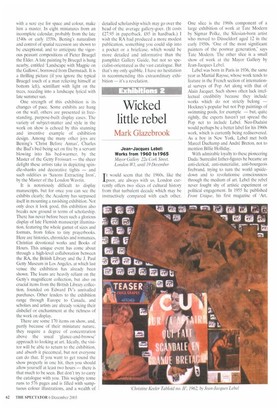Wicked little rebel
Mark Glazebrook
Jean-Jacques Lebel: Works from 1960 to1965 Mayor Gallery 22a Cork Street, London W1, until 19 December
It would seem that the 1960s, like the poor, are always with us. London currently offers two slices of cultural history from that turbulent decade which may be instructively compared with each other.
One slice is the 1960s component of a large exhibition of work at Tate Modern by Sigmar Police, the Silesian-born artist who moved to Dusseldorf aged 12 in the early 1950s. 'One of the most significant painters of the postwar generation,' says Tate Modern. The other slice is a small show of work at the Mayor Gallery by Jean-Jacques Lebel.
Lebel was born in Paris in 1936, the same year as Martial Raysse, whose work tends to feature in the French section of international surveys of Pop Art along with that of Alain Jacquet. Such shows often lack intellectual credibility because they include works which do not strictly belong — Hockney's popular but not Pop paintings of swimming pools, for example — but, quite rightly, the experts haven't yet spread the Pop net to include Lebel. Neo-Dadaist would perhaps be a better label for his 1960s work, which is currently being rediscovered. As a boy in New York, Lebel met both Marcel Duchamp and Andre Breton. not to mention Billie Holliday.
With admirable loyalty to these pioneering Dada /Surrealist father-figures he became an anti-clerical, anti-materialist, anti-bourgeois firebrand, trying to turn the world upsidedown and to revolutionise consciousness through the medium of art. Lebel the rebel never fought shy of artistic experiment or political engagement. In 1955 he published Front Unique, his first magazine of 'Art, Poetry and Politics'. This was in Florence, where Lebel also held his first exhibition in the same year. In 1957 he showed at Galerie Iris Clert, Paris. In 1960 he staged the first European 'Happening'. It is perhaps as an organiser of 'Happenings', which led to friendships with Claes Oldenburg, Allan Kaprow and others in New York, that Lebel is best known. In 1960161 he organised an international touring exhibition in protest against the war in Algeria.
It would not surprise the current Bush administration, assuming that it contains some cultural experts, to learn that in the 1960s both Polke and Lebel mocked. in different but typically 'old Europe' ways, what they saw as America's materialistic celebration of consumerism. In order to do so, however, both the German and the French artist were lured into sharing the techniques or subject-matter of Anglo-American Pop. For example, there were some images of French pin-up girls in the case of Jean-Jacques Lebel and some images of German sausages in the case of Sigmar Polke.
The frankfurters in gloss paint which constitute Polke's painting Wiirstchen' (1964) are laid out more or less at random on the canvas turning the painting into a species of abstract. The light-hearted wit in Polke's arrangement of German sausages is absent from his recent more technically inventive work. The latter unfortunately comprises the bulk of the Tate Modern show. It's true that Andy Warhol liked Swedish Design 'because it's so boring', as he put it, but, sad to report, Polke's recent work easily outbores Swedish Design.
After seeing Polke's big, predominantly bland exhibition, therefore, it's a pleasure to discover Lebel's wicked little show, although I'm not sure I like it in the way that the artist intended at the time. Since no lesser an art historian than the late Professor Gombrich once stated that there were no wrong reasons for liking works of art, I admit that what drew me in was the French newspaper image of Christine Keeler in a bathing suit. 'SUR LAFFAIR QUI FAIT SCANDALE EN GRANDE BRETAGNE' we read. Forty years on, the scandal can provoke waves of nostalgia.
Once drawn in, however, Lebel's works of the early 1960s are worth studying carefully. He knows how to create an arresting image. His paintings and collages, often a mixture of both, can be rich in fascinating detail. He is adept at the technique, used by Rauschenberg, of paraffin transfer, by which images are lifted direct from newspapers without recourse to the collagist's scissors. A detail in Lebel's 'Portrait de Meret Oppenheim II' (1964), a collage with paint on wood, shows a cup of hot chocolate, the drink that's warm as mink' surrounded by fur. Both the advertisement and Lebel's collage are testaments to the strange power of Opperiheim's iconic furlined tea-cup. They are testaments, too, both to Dada /Surrealism and to the strange power of art.



























































































 Previous page
Previous page